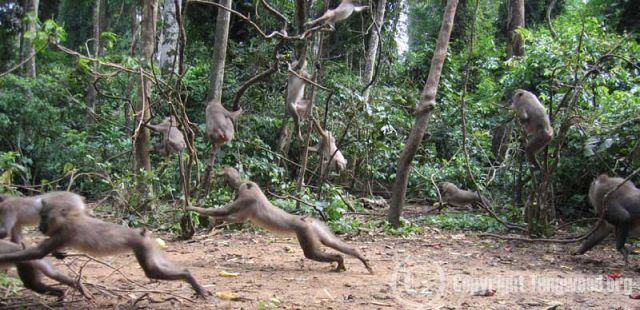Threats to Drills
Drills prefer dense, primary forest and will flee from a human's approach. This flight is part of their predatory escape pattern. Unexpected loud noises or sudden movement will result in group flight - i.e. everyone startles and runs. Part of this behavior is a nonspecific 'go up' response. Often, drills will climb up into the nearest tree to get away from danger. When the predator is part of their natural habitat, such as the leopard, this is a good idea - drills can climb much higher than leopards and can also leap from tree to tree (see the video link to Mandrillus locomotion above). However, when it is a hunter with a dog chasing them, climbing up may not be a good plan -especially as the tree they climb may not be the largest or tallest in the forest, but only the closest, leaving them exposed. Hunters exploit this, sending dogs in first to frighten the drills upward and then easily shooting a large number out of the trees with guns - a lucrative enterprise since drills are the largest monkey species in their forest habitat. Among the primates, only the great apes (i.e. chimpanzee and gorilla) are bigger than drills and mandrills. Using the method described above, a hunter may be able to kill a large number of drills at one time. The Bioko Biodiversity Protection Program surveys wildlife in the markets of Bioko Island (a part of Equatorial Guinea where drills are found), to try to put numbers to the decrease in numbers primate populations there are sustaining from hunting. In the Bioko markets, the price of drill meat escalates as drills become harder and harder to find - yet they are still present in the markets, and possibly even in increasing numbers! This means the demand for drill meat is still present also, driving hunters to continue hunting. Will they hunt until the last drill is gone...?
The drill is found in a very small geographic area - and one that is populated by a very high density of humans - making drill monkeys one of the most endangered primate species in the world. Though international laws are designed to protect drills, they are not well-enforced. In all of their remaining habitat, drills are hunted, and can be found in local markets as bushmeat, while their forest habitat continues to be destroyed through logging and farming. Like the Nigerian-Cameroon chimp, they will soon go extinct if conservation action is not taken! Won't you help us save them?
























